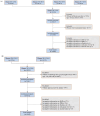The association between eight complete blood count-derived inflammatory markers and muscle health
- PMID: 39963665
- PMCID: PMC11830586
- DOI: 10.3389/fnut.2025.1498757
The association between eight complete blood count-derived inflammatory markers and muscle health
Abstract
Background: Most studies have evaluated sarcopenia and muscle health solely based on muscle mass. This study comprehensively examined the associations between eight inflammatory indicators and muscle mass and strength, with the aim of identifying an indicator capable of evaluating muscle health across multiple dimensions.
Methods: This study included 10,440 participants from the National Health and Nutrition Examination Survey (NHANES, 2011-2018) and 5,384 participants from NHANES (2011-2014). Multivariate logistic regression, smooth curve fitting, restricted cubic spline (RCS) analysis, subgroup analysis, and Spearman's correlation were used to comprehensively assess the associations between the eight inflammatory indicators and muscle mass and strength. Receiver operating characteristic (ROC) curves were used to compare the predictive abilities of the different indices for low muscle mass and muscle strength. Additionally, NHANES data were cross-validated with data from 554 patients at our hospital to evaluate the ability of the systemic immune inflammatory index (SII) to distinguish between low muscle mass and strength.
Results: After controlling for all potential confounding factors, multiple logistic regression analysis revealed that apart from the platelet-to-lymphocyte ratio (PLR), monocyte-to-lymphocyte ratio (MLR), and derived NLR (dNLR), the neutrophil-to-monocyte-plus-lymphocyte ratio (NMLR), neutrophil-to-lymphocyte ratio (NLR), SII, systemic inflammation response index (SIRI), and pan-immune-inflammation value (PIV) were significantly negatively correlated with muscle mass and strength. However, NMLR and NLR were significantly associated with changes in muscle mass only in Q4 (P < 0.05). In the stratified analysis by body mass index (BMI), only the SII, NLR, and NMLR were unaffected by BMI. In the cross-validation, the predictive performance of the SII for low muscle mass [area under the curve (AUC) = 0.699, 0.677, and 0.685] and low muscle strength (AUC = 0.857, 0.849, and 0.840) demonstrated a good reference value. RCS and smooth curve fitting analyses indicated that most inflammatory markers were linearly correlated with muscle health (P < 0.05).
Conclusion: Compared with other inflammatory markers (e.g., PIV and dNLR), the SII demonstrated a more robust predictive ability, was less influence by covariates, and exhibited high generalization performance in internal and external validation. SII may be crucial in identifying "hidden sarcopenia" and the early stages of muscle functional decline.
Keywords: NHANES; indicators; inflammation; muscle mass; sarcopenia.
Copyright © 2025 Zhang, Wang, Liu, Lei, Cheng and Cao.
Conflict of interest statement
The authors declare that the research was conducted in the absence of any commercial or financial relationships that could be construed as a potential conflict of interest.
Figures




Similar articles
-
Association of systemic immune biomarkers with metabolic dysfunction-associated steatotic liver disease: a cross-sectional study of NHANES 2007-2018.Front Nutr. 2024 Sep 4;11:1415484. doi: 10.3389/fnut.2024.1415484. eCollection 2024. Front Nutr. 2024. PMID: 39296508 Free PMC article.
-
Associations of CBC-Derived inflammatory indicators with sarcopenia and mortality in adults: evidence from Nhanes 1999 ∼ 2006.BMC Geriatr. 2024 May 16;24(1):432. doi: 10.1186/s12877-024-05012-2. BMC Geriatr. 2024. PMID: 38755603 Free PMC article.
-
Predictive role of the peripheral blood inflammation indices neutrophil-to-lymphocyte ratio (NLR), platelet-to-lymphocyte ratio (PLR), and systemic immunoinflammatory index (SII) for age-related cataract risk.PLoS One. 2024 Nov 18;19(11):e0313503. doi: 10.1371/journal.pone.0313503. eCollection 2024. PLoS One. 2024. PMID: 39556543 Free PMC article.
-
Inflammatory markers are associated with infertility prevalence: a cross-sectional analysis of the NHANES 2013-2020.BMC Public Health. 2024 Jan 18;24(1):221. doi: 10.1186/s12889-024-17699-4. BMC Public Health. 2024. PMID: 38238731 Free PMC article.
-
The association between systemic immune-inflammation index and chronic obstructive pulmonary disease in adults aged 40 years and above in the United States: a cross-sectional study based on the NHANES 2013-2020.Front Med (Lausanne). 2023 Nov 24;10:1270368. doi: 10.3389/fmed.2023.1270368. eCollection 2023. Front Med (Lausanne). 2023. PMID: 38076255 Free PMC article.
References
-
- Shi C, Cao H, Zeng G, Yang L, Wang Y. The relationship between complete blood cell count-derived inflammatory biomarkers and benign prostatic hyperplasia in middle-aged and elderly individuals in the United States: evidence from NHANES 2001-2008. PLoS ONE. (2024) 19:e0306860. 10.1371/journal.pone.0306860 - DOI - PMC - PubMed
LinkOut - more resources
Full Text Sources

